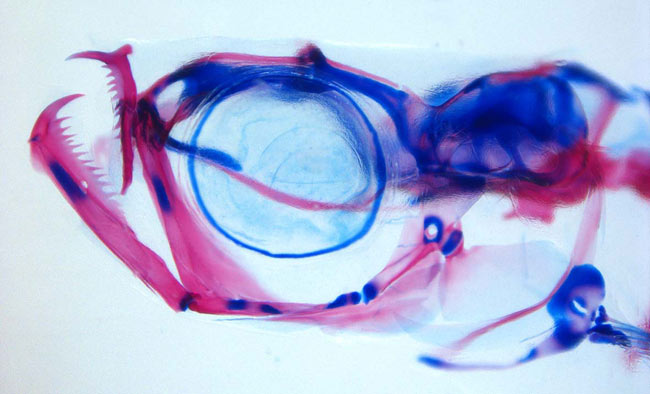A newly discovered family of minnows called vampire fish seems to have taken 30 million years to redevelop the outer fangs after they have lost their vampire-like teeth. in their previous evolutionary stage.
The discovery of this tiny freshwater fish reveals much more information about the path of redevelopment of lost structures, as well as the way in which some species mature sooner. The scientists named the new fish, the Danionella dracula, because they have large fang-like structures in the jaw.
Ralf Britz, a fish researcher at the Museum of Natural History in London, said: 'It is one of the most unusual vertebrates ever discovered within a few decades. come back here'.
Britz discovered this fish in a stream in northern Myanmar during the collection trip. It is transparent and probably less than 1 inch long, it is one of the smallest fish and invertebrate animals.
 Image of the head of a carp-like fish named Danionella dracula. Unlike 3700 other species of the same group, males have teeth-like structures (as shown in the stained image). (Photo: Museum of natural history in London)
Image of the head of a carp-like fish named Danionella dracula. Unlike 3700 other species of the same group, males have teeth-like structures (as shown in the stained image). (Photo: Museum of natural history in London)
All 3,700 other Cypriniform species have consumed teeth since 50 million years ago. Biologically, the regrowth of D. dracula fish is essentially a jaw that grows too strong, not a molar.
However, males and females are not the same. Only males have a face that flattens their fangs. Males also have larger pelvic fins, the anal hole moves forward and the genital hole is located between the pelvic fins.
Males use their fangs to fight to preserve the territory, they stab into each other and bite each other. Their lower jaw can be expanded, forming a 45-60 degree angle to the body's main axis.
 Males of the fish family Danionella dracula have vampire-like teeth. (Photo: Museum of natural history in London)
Males of the fish family Danionella dracula have vampire-like teeth. (Photo: Museum of natural history in London)
D. dracula fish is also very prominent because it has very early physiological development. They mature at much earlier stages, their skeletons are missing more than 40 bones compared to their zebrafish family.
Britz explains: 'Their bones are largely the same as those of larval stage'.
D. dracula dragon fish is not alone because Danionella fish and other relatives also have this unusual characteristic. The researchers call the phenomenon a developmental amputation and they also debate the meaning of the phrase from an evolutionary perspective.
Britz emphasized that: 'Someone could argue that the developmental amputation is actually a dead end. But I thought that the phenomenon released the body from restraint and brought about possibilities for developing in a new direction, replacing the body shape significantly '.
 Discovered an ancient centipede fossil 99 million years old
Discovered an ancient centipede fossil 99 million years old Discovered bat-like dinosaurs in China
Discovered bat-like dinosaurs in China Discovered a 200-year-old bronze cannon of the coast
Discovered a 200-year-old bronze cannon of the coast Discover 305 million-year-old spider fossils
Discover 305 million-year-old spider fossils